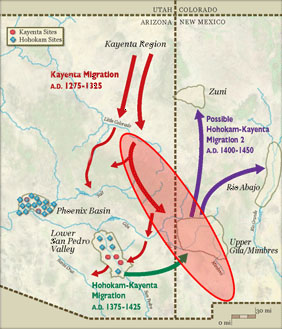Banner image courtesy of Eastern Arizona College
The centuries between A.D. 1200 and 1540 were a time of great change in the Southwest. Deteriorating environmental conditions on the Colorado Plateau in the late 1200s led people to leave the Four Corners region. This movement of northern peoples into the southern Southwest initiated a series of dramatic changes—in how people lived, where they lived, what they believed, and even their ability to survive. Migrants and local groups had to find ways to live together, or at least co-exist as neighbors. By the time the Spaniards arrived, many transformations had taken place—and, as history shows, many more were imminent.
 For more than a decade, Archaeology Southwest sought to understand what happened to southwestern peoples just before contact with the Spaniards. Archaeological evidence indicates that, after 1350, populations appear to decline drastically. We know this by studying the number and sizes of sites that date to this time period. Ultimately, many people left the southern Southwest. Those who remained or subsequently entered the region lived very differently.
For more than a decade, Archaeology Southwest sought to understand what happened to southwestern peoples just before contact with the Spaniards. Archaeological evidence indicates that, after 1350, populations appear to decline drastically. We know this by studying the number and sizes of sites that date to this time period. Ultimately, many people left the southern Southwest. Those who remained or subsequently entered the region lived very differently.
What brought people together and kept communities going even as population declined? What factors caused the dramatic demographic collapse? Archaeology Southwest believes that the answer to the first question is, in a word, Salado.
The story of how we came to this view and the places we have investigated to test its validity comprises several separate projects.
Prelude: What is Salado?
Learn about the Salado ideology, and how we see evidence of it throughout the Southwest.
MoreI: Initial Research in the San Pedro River Valley
Explore archaeological evidence that traces Kayenta groups as they migrated south to the already-inhabited San Pedro valley.
MoreII: Coalescent Communities
Explore lines of evidence for thinking about the Salado phenomenon and population decline across the southern Southwest in the centuries before the arrival of the Spaniards.
MoreIII: Following the Kayenta and Salado Up the Gila
When Salado groups left the San Pedro valley and other parts of southeastern Arizona in the late 1300s, they came to this region.
MoreDetails
Related to This
-
Post Faces of Salado?
-
Project The Edge of Salado
-
Location Besh Ba Gowah Archaeological P...
-
Location Tonto National Monument
-
Post What’s in a Notch?